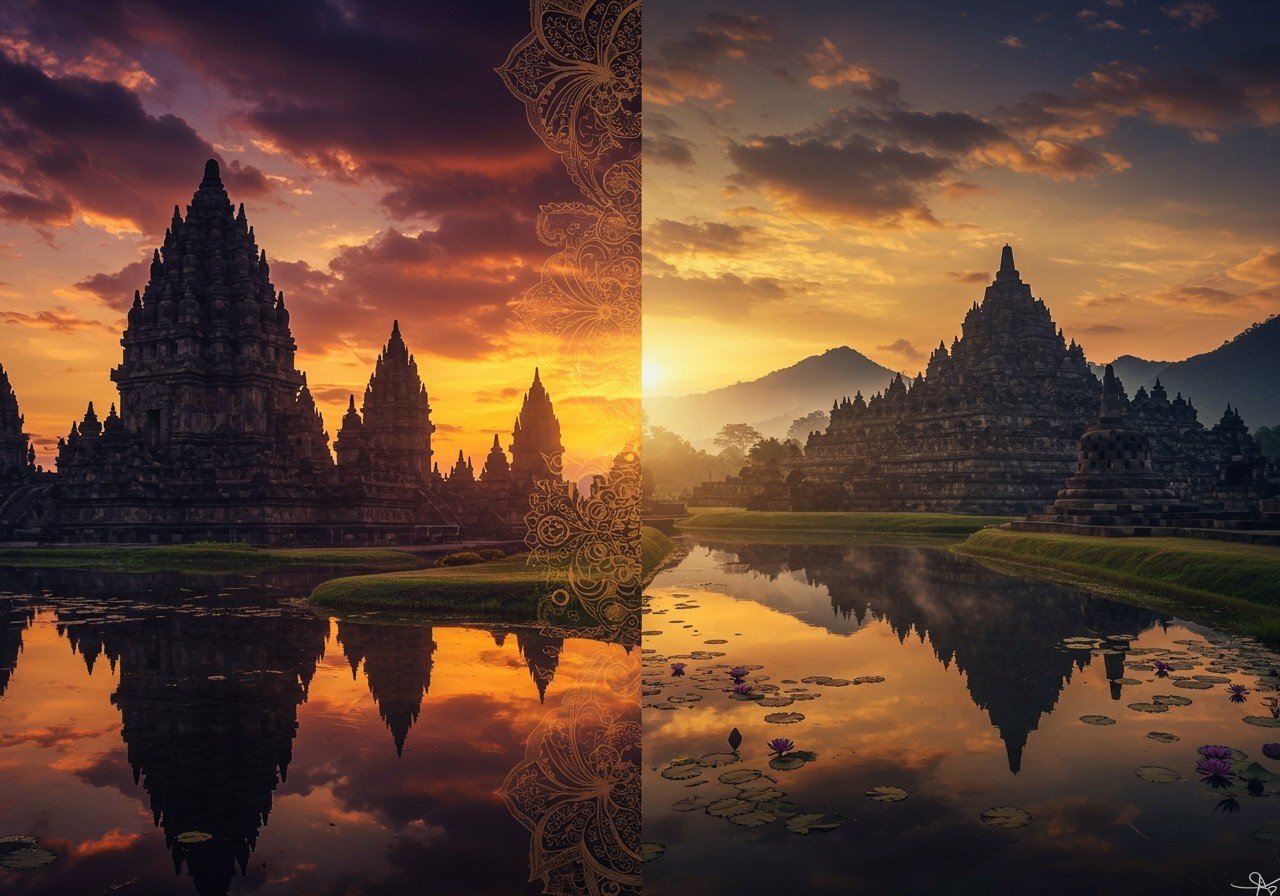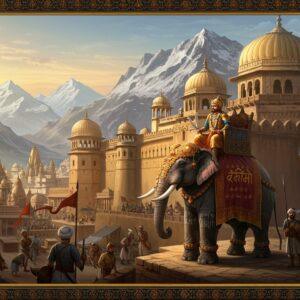
Namaste, fellow travellers! Let’s embark on a virtual yatra to the enchanting island of Java, home to two of Indonesia’s most revered temples: Prambanan and Borobudur. These UNESCO World Heritage sites whisper tales of ancient kingdoms, deep spiritual beliefs, and architectural marvels. As Indians, we have a natural affinity for the sacred, and this guide will resonate deeply with our cultural values as we explore these magnificent monuments.
Whispers of History: Java’s Ancient Temples
Both Prambanan and Borobudur carry the weight of centuries past. Borobudur, a majestic Buddhist temple built in the 9th century under the Sailendra Dynasty, stands as a testament to a time when Buddhism flourished in Java. Imagine pilgrims circumambulating the massive stupa, their prayers echoing through the ages. Prambanan, also dating back to the 9th century, tells a different story. This Hindu temple complex, built by the Sanjaya Dynasty, is dedicated to the Trimurti – Brahma, Vishnu, and Shiva. Its towering spires reach towards the heavens, a symbol of devotion and intricate artistry.
Architectural Wonders: A Symphony in Stone
The architectural styles of these temples are as distinct as the faiths they represent. Borobudur is a massive single stupa, resembling a step pyramid. Its nine stacked platforms are adorned with thousands of intricate relief panels depicting the Buddha’s life and teachings, as well as countless Buddha statues. Visualize the devout climbing to the top, their spiritual journey mirrored in their physical ascent. Prambanan, on the other hand, is a complex of temples with tall, pointed towers characteristic of Hindu architecture. The central complex is dedicated to Shiva, flanked by shrines to Brahma and Vishnu, their intricate carvings narrating tales from Hindu mythology.
A Cultural Tapestry: Spiritual Significance
Both Prambanan and Borobudur hold deep spiritual significance. Borobudur, a place of pilgrimage, symbolizes the journey towards enlightenment. Its reliefs depict the Buddha’s teachings and inspire introspection. Prambanan, with its depictions of Hindu deities, offers a glimpse into the rich tapestry of Hindu mythology. The Trimurti, representing the forces of creation, preservation, and destruction, reminds us of the cyclical nature of life. These temples highlight the harmonious coexistence of different faiths in ancient Java.
Experiencing the Divine: A Visitor’s Guide
Visiting these temples is a deeply enriching experience. Guided tours, visitor centers, and cultural performances enhance our understanding. At Borobudur, witnessing the sunrise over Mount Merapi is an unforgettable experience, bathing the temple in a golden glow. Prambanan’s proximity to Yogyakarta adds to the vibrancy of the visit. Explore the bustling city, savor local delicacies, and immerse yourself in Javanese culture.
Prambanan or Borobudur? A Matter of the Heart
Choosing between the two depends on what resonates with your soul. Are you drawn to the serenity of Buddhist philosophy and the unique stupa architecture of Borobudur? Or does the grandeur of Hindu mythology and the towering spires of Prambanan beckon you? Perhaps, if time permits, the best option is to embrace both, allowing each temple to weave its magic.
Borobudur: The Path to Enlightenment
- Type: A magnificent 9th-century Mahayana Buddhist temple.
- Significance: The largest Buddhist temple in the world, a UNESCO World Heritage Site, and a beacon of Buddhist teachings.
Prambanan: An Ode to the Trimurti
- Type: A sprawling 9th-century Hindu temple complex.
- Significance: The largest Hindu temple site in Indonesia, second only to Angkor Wat in Southeast Asia, dedicated to the divine Trimurti
Making Your Choice: A Soulful Decision
- Religious Interest: For those seeking the serenity of Buddhist history and philosophy, Borobudur offers a profound connection. For devotees of Hindu mythology and traditions, Prambanan is a sacred haven.
- Architectural Splendor: Borobudur’s intricate carvings and the massive single stupa inspire awe. Prambanan’s towering spires and detailed sculptures ignite the imagination.
Both temples were abandoned in the 10th century due to volcanic eruptions, only to be rediscovered and restored in the 19th century. Located in Central Java, they are easily accessible from Yogyakarta. Many tours combine both sites into a single day trip, but immersing yourself in each temple’s unique atmosphere across separate visits might be more fulfilling. Some travelers find Prambanan more immediately rewarding, especially those with limited time. Ultimately, the choice is yours – a pilgrimage to one or a blessed journey to both.
Poojn.in: Your Spiritual Companion
For those visiting Prambanan, and other sacred sites in India dedicated to Lord Shiva, Poojn.in offers a wide selection of puja items and samagri to deepen your spiritual connection. Prepare for your temple visit with authentic, high-quality items:
- Pure Brass Lord Kubera Murti: Invite the blessings of prosperity and abundance into your life with this beautifully crafted idol.
- Pure Brass Panchmukhi Hanuman Ji Idol: Seek the strength and protection of Lord Hanuman with this powerful murti.
- Incense Sticks and Dhoop: Create a sacred atmosphere with fragrant incense, enhancing your prayers and meditation.
Visit www.poojn.in to explore our complete collection. Our products are carefully selected for quality and purity, ensuring your puja rituals are performed with utmost reverence. We understand the importance of authentic puja items, and we are here to support your spiritual journey. Call us at 03369029784 or WhatsApp us at 9476142738 for personalized recommendations and assistance.
While Borobudur is a Buddhist temple, the offerings from Poojn.in are particularly relevant to Hindu devotees visiting Prambanan, where Hindu rituals and offerings are customary.
Java’s Timeless Treasures: A Journey for the Soul
Visiting Prambanan and Borobudur is more than sightseeing; it’s a pilgrimage, a spiritual awakening. These temples are living testaments to Java’s rich cultural heritage, offering a glimpse into ancient civilizations that continue to inspire. Whether you are drawn to the serenity of Borobudur or the majesty of Prambanan, each visit promises to deepen your understanding of Southeast Asia’s spiritual legacy.
Frequently Asked Questions: Your Queries Answered
What sets Prambanan and Borobudur apart? Prambanan, a Hindu marvel, showcases tall, pointed architecture, while Borobudur, a Buddhist sanctuary, boasts a unique step-pyramid design. Both are UNESCO World Heritage Sites, each reflecting a distinct spiritual journey.
Which temple is older? Borobudur, built in the 9th century, predates Prambanan, constructed later in the same century. Both temples represent the rich artistic traditions of their respective faiths.
When is the best time to visit? The dry season (May-September) offers pleasant weather for exploration. Early mornings or late afternoons provide the ideal lighting for capturing the temples’ beauty and serenity.
Ram Raja Temple Visit: A Complete Guide
Yameshwar Temples in India: Significance and History


